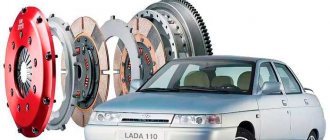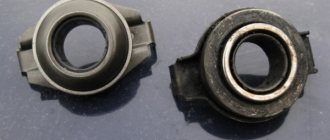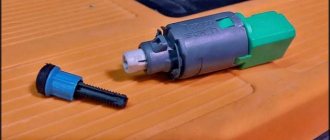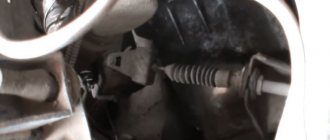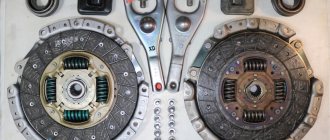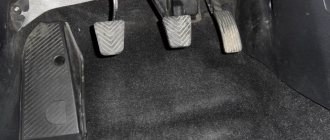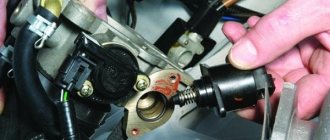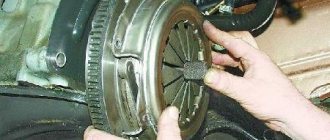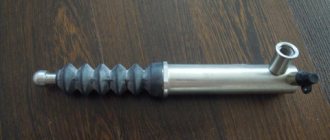On your own, if the gearbox is mechanical:
Using the gas pedal, changing the speed, catch the moment when you can directly engage first or second gear. You shouldn’t do a big one, because on the third hill you may not be able to pull it out.
Be prepared for a sharp jolt in the cabin. Yes, of course, the gearbox and motor will take a hit, but there’s no choice here.
Everything is clear with the first and second methods, but the third can be supplemented with another one under the guise. After the clutch pedal has failed, try to pull the car up to the slope and stop on it. Stop the engine and engage first gear. We simultaneously turn the ignition key and press on the gas pedal to try to start the car. After a successful attempt, we move home or to the station.
Don't change gears
, since there is a high probability that the engine will stall. And all the work is down the drain. This method will be relevant if the battery is well charged, otherwise it will be ineffective and you will have to wait for the pusher. When driving in this manner, the speed should be no more than 20 km/h. and be sure to turn on your hazard lights so other drivers can see you.
Assess your travel route in advance to avoid traffic jams and congestion. Stay in the far right lane.
Why and where do the pedals on the VAZ-2110 fail?
Tens clutch diagram. There was nothing new for those times!
Of course, everyone who drives a VAZ-2110 knows the structure of the single-plate dry clutch mechanism and its drive. As on all inexpensive cars, the simplest clutch is not activated hydraulically, but mechanically: we press pedal 9, the pedal pulls the cable, the cable drives the fork 4, and the fork pushes the release bearing 13, which acts on the blades of the pressure plate 6 The release disk is removed from the driven disk 7, the clutch is disengaged.
If at least one of the elements of this chain loses its properties (strength, elasticity, integrity), the pedal simply falls to the floor or the clutch does not disengage, partially or completely.
Let's look at the most common faults typical for machines of the tenth family.
Clutch release fork
The clutch fork either bends or cracks the lever, or the legs wear out at the points of contact with the bearing coupling.
It’s not for nothing that we started rating faults not with the cable, which would be more logical to assume, but with the fork. The design and materials of this element are chosen so poorly that some people manage to change 3 plugs in a year . The symptoms of a breakdown are simple - a sudden drop in the pedal to the floor. In this case, the fork sometimes does not break completely, but breaks, creating the illusion of a whole element.
Typical clutch fork failure.
It’s easy to calculate the breakdown - open the hood and move the fork with your hands.
If it dangles freely, cracks or breaks are visible, we get to a spare parts store, buy a new fork and replace it; to replace it, you will have to partially remove the gearbox. The price of a new fork is no more than 500 rubles, and they sell it according to the factory article number 21100-1601200 . There are also cheaper forks on sale from other manufacturers, and there are reinforced designs that are more expensive.
Clutch fork in removed gearbox.
To replace the fork, just move the gearbox slightly away from the engine.
Clutch cable
Failures occur much less frequently than forks and, with gentle use, can survive more than one clutch set.
Frayed cable.
The cable breaks in several places - near the pedal itself, at the bend in the engine compartment or at the end switch, on the adjusting rod. The breakdown is also immediately noticeable: the cable is weakened, sometimes the breakage points are visible.
In rare cases, the cable breaks right in the casing, this can also be diagnosed quite easily - we pull on any accessible end of the cable, if it gives in and can be removed without problems, we buy or take a new one out of the trunk. Its catalog number is DAAZ 2110-1602210 , and they ask for a cable from 370 to 450 rubles, depending on the manufacturer.
New cable for VAZ-2110.
Drive and its adjustment
To begin with, if the reason is still in the cable and it needs to be changed, dismantle the old part.
It is attached directly to the gearbox with a bracket. Here you also need to unscrew all the bolts and nuts slowly and evenly. Next, the fork is disengaged after the cable has been slightly loosened, but not completely removed. The cable itself needs to be looked for under the hood of the vacuum hydraulic booster of the brake system. Use a screwdriver or other similar element to pry up and remove the locking bracket, and only then dismantle the part. Sometimes the reason is not in the cable, but in the bushing to which it is attached. It may be bent or out of order, making it difficult to secure even a new cable correctly. Therefore, if a breakdown occurs, then this part is also replaced. It is also advisable to lubricate the new cable with a special compound to prevent damage from friction.
This part requires regulation if installed in a VAZ-2110. It's easy to check everything. Take a ruler and measure the distance from the floor to the pedal strictly perpendicularly. If it is more than 16 centimeters, then all excess on the cable is cut off. When the new element is installed in the reverse order, you need to get behind the wheel and try the precision of the pedal.
What to do if the clutch pedal suddenly fails?
Imagine a situation where you are calmly going about your business and suddenly there is a click and the clutch pedal falls to the floor or when pressed it begins to rest against something. The first thought is that you are left without a clutch, and without it you can’t even engage a gear. It's right. But let's not panic, but let's figure out what could be the matter and how to move on. Usually, shortly before a breakdown, the clutch pedal becomes stiffer, you have to exert more effort to press it than before - this is the surest sign of an imminent breakdown of the clutch, or rather one of its components.
To determine the breakdown, let's start with what kind of clutch it is. It can be cable or hydraulic. In the first, pressing the pedal activates the cable; in the second, when pressing the pedal, energy is transferred to the hydraulic clutch system.
Possible reasons for clutch pedal failure
The clutch pedal is depressed when depressed and does not return
This problem can be easily solved in stationary conditions either at a service station or with your own hands in the garage. To replace or repair the main clutch or control valve in the garage, you must have repair kits for the clutch slave and master cylinders.
Reasons for failure and non-return of the clutch pedal of VAZ2106 and VAZ2107:
- a break in the clutch cable where the tip touched. This problem is not easy to fix on your own. You can, of course, carry a spare cable with you just in case, but cases are different and it is not realistic to provide for everything;
- the spring that performs the function of returning the pedal to its original position may burst or fly off. If the spring has flown off, then it is enough to put it back in place, and if it has burst, then, as in the case of a cable break, you must either tow the car or try to get to the garage or service station under your own power.
Driving without a clutch: what you need to know
Taking into account the fact that most breakdowns that are associated with the clutch or clutch pedal (for example, the clutch pedal has failed) can take the driver by surprise, and it is often impossible to fix problems on the spot, the only option is to drive to the service station under your own power.
If it is not possible to call a tow truck, and it is also not possible to tow the faulty car, you can drive to the repair site without a working clutch pedal. Next, we will look at the simplest method that even a driver who has not previously had such experience can use.
We also recommend reading the article about what a clutch cylinder is. From this article you will learn about the structure of the clutch cylinder, its malfunctions, signs of problems and repairs.
At the same time, we draw your attention once again to the fact that the methods described below should be used only in cases of extreme necessity, since the risk of damaging the box or getting into an accident increases significantly.
Note for drivers
If you keep your foot on the clutch release pedal for a long time, then the clutch will quickly burn out and you will have to change it:
- This truism is often violated by new drivers.
- This does not happen due to forgetfulness, but simply driving a car with the clutch half depressed is more convenient and much easier
- That is why for most car enthusiasts, clutch failures became the reason for their first repair, a new car
- The clutch operation must be checked before each trip to a driving school, and the diagnostics performed often indicate the need for urgent repairs; malfunctions are usually associated with replacing friction discs
The clutch pedal on a VAZ-2110 has failed, what should I do?
Breakdown is different, each one manifests itself differently. One can fray your nerves for years, disappearing and appearing again, while the second appears instantly and at the most inopportune moment. One of these is the failure of the clutch pedal on the VAZ-2110. The case, of course, is unpleasant, but far from fatal. In most cases, every motorist will be able to restore the clutch's functionality with his own hands; the main thing is to know the reasons and what to do.
Replacing and repairing the clutch system
If the VAZ-2110 clutch pedal fails, quite often this indicates wear and failure of the entire clutch system. Here you can give the following algorithm of actions on the part of the car owner:
- first dismantle the gearbox;
- after this, unscrew 6 bolts that secure the casing and flywheel;
- you need to unscrew them evenly, and not one by one; if they do not turn, tap the parts a little;
- After this, the shafts are dismantled. If any of them have cracks or any damage, then the reason for the falling pedal is obvious and needs to be replaced;
- the new driven shaft is installed with the protruding side facing the pulley;
- the frame is inserted into the crankshaft hole and fixed again evenly and very carefully.
Causes and repair of a failing clutch pedal in a VAZ-2110
This is a fairly popular model of the domestic concern. It is distinguished by its versatility, reliability on various types of roads and inexpensive price. The technical characteristics of the car indicate that it is a five-seater vehicle, with an engine in the front and front-wheel drive. In popular usage this model is called the “tenth” or “tenth”. The clutch here is single-plate, dry with a diaphragm spring. The drive is driven by a special cable.
Most often, problems are observed if the cable is torn, then the pedal can not only fall to the floor, it completely refuses to work. It is much more unclear what this phenomenon means if the cable is intact, but a malfunction still occurs. In general, there are a lot of reasons for this, since the clutch is one of the most vulnerable points of a VAZ car, not only of the tenth model, but also of any other.
Why did the pedal start to fail?
In most cases, the reasons for this malfunction are the following:
- The cable connecting the pedal to the tip is broken.
- There is a burst or cracked release spring.
- One of the clutch elements is oily. This could be a flywheel, a pulley, or friction linings.
- Quite often the cause is general wear and tear of the clutch system.
- The clutch drive is damaged.
- Unadjusted pedal mechanism.
As you can see, the list is large, but not all problems here are critical and complex. For example, in the case of excess oil, it will simply be enough to clean and grind the parts.
In the first and second cases, it is necessary to completely replace the failed parts - cable or spring.
Hydraulic failure
Some VAZ models have a hydraulically driven clutch. This system involves:
- line where the special liquid should be located;
- slave and master cylinders.
Here the base of the pedal is fixed to the piston rod of the latter. Pressing it squeezes out the liquid, and it goes into the working cylinder, which acts on the fork. Thus, the pedal on a VAZ can fail if the system loses its tightness. First of all, you need to see whether there is enough liquid left in the tank located in the engine compartment. Proceed like this:
- make up for its deficiency;
- monitor the stability of the level.
If the liquid quickly runs away, then the reason why the pedal may fail is obvious - a leak has started somewhere. To eliminate the latter, you will have to inspect all the pipes and their connections. Cracks in the hoses are wrapped with electrical tape, and the fittings are tightened.
When it drips directly from the rod under the pedal, there is no doubt that the VAZ master cylinder has given up its life. The old element will need to be dismantled, and then:
- disassemble;
- change leaky cuffs and seals.
Deaeration of hydraulics
After repairing the cylinders or eliminating the leak that caused the pedal to fail, it is necessary to bleed the system to remove air from it.
You should hire a partner for the job. The procedure is as follows:
- the protective cap is removed from the fitting of the VAZ master cylinder;
- instead, a hose of a suitable cross-section is put on;
- the end of the latter is placed in a jar, into which a couple of glasses of brake fluid are first poured;
- then loosen the fitting a little and press the pedal a couple of times, and then leave it in the lower position;
- At the same time, monitor the liquid level in the tank;
- when the air stops coming out in the form of bubbles, the fitting is tightened and the pedal is released.
Causes of failure
Clutch problems are a common problem with cars, caused primarily by improper use and wear of parts. Be that as it may, to troubleshoot the problem, it is important to know the reasons why the clutch pedal fails.
There are several of them:
1. Cable break. One of the most common problems is damage to the clutch cable. The weak point is in the tip area where the cable is connected to it in the engine compartment. The solution to this problem is to replace the cable, which can be done without the involvement of specialists. How to eliminate clutch pedal failure will be discussed below.
2. Breakage of the return spring. During operation, the spring mechanism that ensures the return of the lever to the upper position often fails. If the spring breaks, the only solution is to replace it. Replace it locally or at a service station.
Broken clutch pedal spring
There are situations when the spring simply falls off. In this case, find it and install it in place. After this, check the clutch operation and continue driving.
3. Air entering the hydraulic drive - for VAZ 2101-07 vehicles. If such a malfunction occurs, bleed the system. If there is no suitable tool, then call a tow truck or a garage.
4. Failure of the release fork. This unit is mounted on the car’s gearbox, and its service life is not that long. What to do if the clutch pedal fails due to a broken unit? The solution is to replace the failed element. When performing work, check the condition of the clutch disc and also change it if necessary.
5. Problems with the master cylinder. Situations are possible when one of the cylinders “pierces”, defects appear on it or the cuff is torn. If pedal failure is caused by this fault, all is not lost. Press the control lever sharply several times, after which the latter can return to its place.
6. Failure of the driven disk. If clutch pedal failure is caused by a failed disc, diagnosing the cause is easy. In this case, the pedal becomes pliable and soft. The malfunction is often caused by deformation of the unit, broken drive disk, leakage or mechanical damage.
What can cause a pedal to fail?
The search for the cause should be carried out using a heuristic method, that is, start with the simplest and, therefore, easily fixable breakdown, gradually (if there is no result) moving on to complex ones.
So, in particular, the clutch control mechanism on the 2110 stops working due to the fact that the spring responsible for returning the pedal to its original position comes off of it. It is not difficult to fix the problem by installing this element in place or at least securing it (if it is broken) so that there is enough for the trip to the auto shop.
The next option is failure of the pedal axle. It quite often rusts, becomes clogged and, accordingly, jams. This is where you'll have to do some cleaning. More trouble is caused by a broken cable at the point where it is attached to the foot mechanism. Here the connection is restored in any convenient way.
If nothing happened to the pedal and the ends of its drive, located in the cabin, look intact, then you will have to climb into the engine compartment. For example, the cable can simply jump off the fork - this very often happens in VAZ-2110 cars and even some foreign cars. Put it back in place and the unit will work as it should again.
Sometimes the clutch pedal falls through and cannot be returned to its original position, even with noticeable effort. This happens when the cable gets stuck in its casing. This breakdown is caused by dirt accumulated inside. The easiest way is to replace the flexible rod with a VAZ, but if this is not possible, then you will have to act differently:
- run lubricant into the casing to the maximum depth;
- put the cable in place;
- push it apart with the pedal;
- when the latter returns to the top position, press it 3-5 times until it stops so that the lubricant covers the entire rod.
An important point is to use VD-40 optimally.
It will be worse if the cable breaks - in this case, the clutch will definitely not work without a new one.
Clutch failure
The pedal may also fail because the clutch mechanism has failed. It is this reason that you should think about when it turns out that the hydraulic system is working as it should.
Here you need to find out which part is damaged. There are several options, but most often the problem is caused by a sticking axle on which the release fork is installed. In addition, the foot element sometimes fails when worn out:
- diaphragm spring on the drive disk;
- release bearing located in the clutch.
To carry out diagnostics, you will have to disassemble the clutch. All damaged elements are replaced with new ones, which is impossible to do in the field.
Possible defects
But it is also worth noting that when diagnosing or repairing a car’s transmission, a lot of deformed and damaged elements are revealed. Now it’s worth thinking about which of them can cause the clutch pedal to fail. Or literally everything can fail. Damper and diaphragm springs, clutch basket, driven disc, even the flywheel. Sometimes the clutch fork starts to jam. This often happens because the bronze bushings wear out. If the clutch pedal just squeaks, then there is no need to worry at all, just lubricate the spring. There have been cases when the release bearing has failed. It simply breaks into several small pieces and spills inside the crankcase. Because of this, the clutch pedal becomes soft, the drive and driven discs do not open. This, of course, makes you panic.
Typical Ford Focus II clutch malfunctions
Let's look at the cases in which Ford Focus 2 clutch replacement
or repair of its individual components:
- incomplete shutdown;
- incomplete inclusion;
- increased noise when the clutch is engaged;
- vibrations;
- Difficulty shifting gears.
Craftsmen recommend installing all new parts at the same time, and not just worn-out ones. This is explained by the labor-intensive nature of the process, and the service life of undamaged structural elements has already been reduced and they will soon also require replacement. The owner decides what to do.
How to get to a car service center if the pedal fails
When it turns out that the detected breakdown cannot be repaired on the spot, you will have to think about how to take the car to a service station or garage. If it happens during rush hour, it is safer to call a tow truck or have someone tow you. On busy roads or at night, you can get there on your own. How to do it? We tell you:
- the car is set to first speed;
- starts;
- then press the gas a little and the VAZ will slowly move off.
Be sure to turn on your hazard lights. It is also useful to think through the route in advance - it is important to constantly move along the main road, avoid traffic lights, crossings and any stops. When you can’t do without the latter, turn off the engine completely.
It is forbidden:
- dangerous to maneuver;
- change gears.
All this will lead to a breakdown of the gearbox, the repair of which costs much more than fixing a clutch malfunction or calling a tow truck.
How to fix problems with the VAZ 2107 clutch with your own hands?
Life is full of surprises. And especially for motorists. Not only do you need to be constantly attentive on the road, but you also need to be able to notice and fix problems in your car in a timely manner. Especially when there are no populated areas nearby and the nearest service station is far away, or when you are stuck in a traffic jam and the clutch pedal is stuck or the brakes have disappeared.
This problem is a constant topic of discussion on many forums for car owners of almost all brands. Of course, a clutch can fail for many reasons. Let's look at the most common cases of problems with the clutch pedal of the VAZ 2106 and VAZ 2107.
What to do?
So, your pedal has fallen or is slipping, what to do in such cases? You have no other choice but to solve the problem. You have two options: turn to professionals for help and spend money on a service station, or take the initiative into your own hands and fix the problem yourself. Next, we will tell you how to do it yourself.
Cleaning system elements from oiling
- First of all, you need to disconnect the battery, since to clean the flywheel and other elements of the system, you will need to dismantle the gearbox. And since when dismantling the box you will need to disconnect the electrical connectors, the battery should be disconnected.
- Remove the gearbox. If you do not have enough experience and knowledge for this, then it is better to seek help from a service station.
- Next, you need to unscrew the screws that secure the flywheel. Try to keep it from turning when you remove the screws. Remove the flywheel and clean it with white spirit or acetone. You can also use gasoline for these purposes. Do similar actions with the pressure and driven disk if these components are oily. Before direct installation, cleaned elements must be wiped dry. Please note: if the driven shaft is too oily, it would be more advisable to replace it, since in practice cleaning the element rarely helps.
- It is also necessary to eliminate the cause of the oiling. In VAZ 2110 cars, oil leaks can occur through the gearbox or engine seals.
- Reassemble everything in reverse order.
Clutch replacement
One of the reasons why the pedal fails may be the inoperability of the clutch.
- After removing the gearbox using a wrench, you will need to unscrew the six bolts that secure the clutch housing to the flywheel. If you have difficulty unscrewing the screws, tap the heads with a hammer. The screws must be unscrewed evenly, not one by one.
- Having done this, you can dismantle the driven and drive shafts. If you see mechanical damage on these elements, then, most likely, the clutch is slipping precisely because of this. You need to change disks.
- Install a new mechanism. In this case, the driven shaft must be installed with the protruding side facing the drive pulley. Mount the centering mandrel.
- Insert the frame into the crankshaft hole. In this position you need to secure the drive pulley of the device. Again, this should be done evenly, tightening the screws one turn at a time rather than one at a time.
Drive replacement and adjustment
- If the pedal in your VAZ 2110 has failed or is slipping, then one of the most common reasons for this may be a failed cable. To replace the cable, you need to remove it from its installation location, namely the bracket, which is installed directly on the gearbox.
- Unscrew the nuts that secure the cable to the bracket. To do this, you will need wrenches 2 and 19. Loosen the bolts and remove one part of the cable from the installation location. After this, it must be disengaged from the fork, which engages the clutch.
- Now the cable must be disconnected from the pedal. Open the hood and locate the cable housing, which is located next to the vacuum brake booster. The casing must be removed, but before doing this, unscrew the fastening bolt with a Phillips screwdriver. Next, pry up with a screwdriver and remove the locking bracket. After this, the cable can be removed.
- Perform a visual inspection of the bushing onto which the cable is attached. If excessive wear occurs, this component must be replaced. Do not forget to lubricate the new cable lead, as well as the place where it connects to the pedal, with grease. For this you can use the traditional “Litol-24”.
- Now you need to adjust the cable. To do this, take a ruler and, placing it against the pedal, place it perpendicular to the floor. Measure the distance from the floor to the pedal using a ruler. If it is more than 16 cm, then the cable needs to be adjusted.
- Under the hood, loosen the control nut at the end of the cable. The adjusting nut is also located here. You need to rotate it until the full pedal travel does not exceed 13 centimeters. 12-13 cm is the optimal full travel for the VAZ 2110 clutch pedal.
- Sit in the driver's seat and press the accelerator as far as it will go several times, then measure again. If necessary, adjust it again. Tighten the control nut and slide the rubber stop sleeve all the way.
What to do if cable adjustment does not help
If the cause of the problem is a worn cable, then it simply needs to be replaced.
If the cable is faulty, then the clutch may simply fail during a trip. Then the possibility of an accident increases sharply. You can change it by doing the following:
- the nut that secures the torso to the bracket must be loosened with an open-end wrench;
- After this, the cable can be removed. They do this very carefully;
- then it is disconnected from the clutch fork;
- then the cable is disconnected from the pedal. To do this, remove the protective cover and lock nut. After this, the pedal can be removed;
- Assembly should be done in reverse order. During this process, it is advisable to lubricate the parts with lithol.
The clutch in a car works under constant intense load when traveling. Therefore, it is not surprising that it wears out over time. Therefore, it may be necessary to compensate for its wear. For this purpose, adjustments are made. It is not difficult to perform such actions. Any beginner can handle this task. Therefore, there is no need to send the car to a technical service. The exception, perhaps, is cases of acute lack of time. A car enthusiast simply has no time to do this.
Sometimes adjustment can correct the deficiency by compensating for clutch wear. But in some cases it is so large that the cable has to be completely replaced. If any signs of wear are detected, it is better not to rely on the Russian “maybe”, but rather to immediately change the clutch elements. This will prevent the risk of emergency situations, because the clutch may simply fail while driving. Then trouble cannot be avoided.
Unexpected breakdowns along the way
You all know that the road is a real test for the driver. And if, in addition to all this, some kind of car breakdown occurs, then the person experiences even more stress. In this article I would like to talk about the car’s clutch, which may not withstand city travel. Sometimes it happens that the pedal fails. Of course, you can start to worry. But you need to find out the real reasons for this behavior, and then conclude that this breakdown is not very serious, you can fix it on the way, get to the nearest service center or to your home. If the clutch pedal suddenly gets stuck, don’t despair; it’s not difficult to solve this problem.
Replacement algorithm
If the cable is damaged:
- You need a spanner or open-end wrench and pliers.
Remove the cotter pin on the clutch pedal and take out the rod;
Remove the head of the cable tip; In the engine compartment, unscrew the tension nut to free the cable; Remove the cable; Assemble the new one in the opposite direction; Measure the free play of the pedal no more than 3.0 cm, and the total no more than 14.7 cm.
If the return spring breaks:
- We don’t need to go into the salon at all;
- Using a spanner wrench, unscrew the tension nut in the engine compartment;
- Release the cable;
- Carefully and in compliance with safety rules, remove the remnants of the return spring;
- We also put a new one in its place slowly, since you can damage your hand or fingers;
- We stretch the cable;
- Screw on the tensioner;
- Check the free play of the pedal.
- We test the car.
As you can see, there is nothing complicated and the time required is a maximum of forty minutes. Question: the clutch pedal failed on a VAZ 2110 is no longer relevant. Pedal failure is a breakdown that does not require surgical intervention in the engine or transmission, meaning internally. All work is carried out externally and with a minimum set of tools.
Important points when replacing the cable
Unscrewing the fastener
- As practice shows, the procedure for replacing a cable on a “ten” begins in the engine compartment. You are required to hold the fork and at the same time pull the cable that is removed from the fork.
- Then the cable fastener is removed from the bracket, which is located on the gearbox. Having completed this procedure, we go into the interior and dismantle the damaged element, that is, the cable.
- The result of the repair is influenced not only by the quality of the new cable, but also by the correctness of the entire replacement procedure.
- If you are dealing with a “ten” from an experimental industrial batch, then the bracket will be presented as a bolt with a Phillips-head screwdriver. To dismantle such a fastening element, you cannot use a regular screwdriver. A special shortened tool will be required.
- If the cable breaks while driving, you can unscrew the bracket with a handy tool, but through the safety block.
- It is strongly recommended to replace the non-standard bolt with a regular one, which can be unscrewed with a simple wrench.
- Be sure to keep a set of tools in your car, since it is extremely rare for a cable to break at the right moment. There is hardly a right moment for any kind of machine breakdown.

